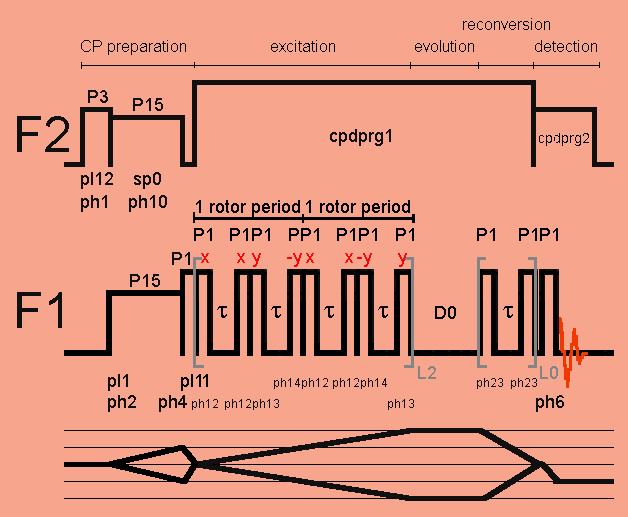
BABA CP/2rotations: 1D/2D CP/double quantum excitation, 2 rotor period, BABA pulse program for TopSpin2.1

BABA CP/2rotations: 1D/2D CP/double quantum excitation, 2 rotor period, BABA pulse program for TopSpin2.1

Since non-phase cycling is applied to the BABA excitation pulse, four-phase cycling is applied to the detection pulse P1 for selecting the 0Q -> -1Q coherence order jump, and four-phase cycling is applied to the BABA reconversion pulse for filtering DQ coherences.
Avoid cross-polarization during BABA excitation and reconversion.
;babacp2 (TopSpin 2.0) ;2D SQ-DQ correlation experiment for 2 rotor period recoupling using BABA ;with cross polarization for weak dipole dipole couplings, compensated for ;pulse imperfections ;M. Feike, D.E. Demco, R. Graf, J. Gottwald, S. Hafner, and H.W. Spiess JMR A 122, 214-221 (1996) ;written by JOS, 11/12/03 ;Avance II+ version ;parameters: ;d1 : recycle delay ;d0 : incremented delay (2D) [1 usec] ;pl1 : for X contact pulse ;sp0 : proton power level during contact ;pl2 : =120dB, not used ;pl11 : for 90 degree X BABA pulses ;pl12 : for decoupling and excitation 1H ;pl13 : for decoulping during recoupling sequence ;p1 : 90 degree X pulse BABA ;p3 : 90 degree 1H pulse excitation ;pcpd2 : pulse length in decoupling sequence ;p15 : contact time ;cnst31 : MAS spinning frequency ;cpdprg1 : decoupling during recoupling, e.g. cw13 ;cpdprg2 : decoupling during evolution periods, e.g. tppm15 ;spnam0 : shape for contact pulse: ramp.100 ;l1 : number of rotor cycles for recoupling, any integer ;l2 : l2*2=l1 = (number of rotorcycles) ;ns : n*32 ;FnMode: States-TPPI or STATES ;$COMMENT=SQ-DQ experiment with BABA for 2 rotor periods, cp excitation ;$CLASS=Solids ;$DIM=2D ;$TYPE=direct excitation ;$SUBTYPE=homonuclear correlation ;$OWNER=Bruker define delay tau "tau=0.5s/cnst31-2*p1" "d0=1u" "in0=1s/cnst31" "d31=1s/cnst31" "l1=l2*2" "l0=2*l1" ;cnst11 : to adjust t=0 for acquisition, if digmod = baseopt "acqt0=1u*cnst11" 1 ze d31 2 10m do:f2 ;F2 decoupler off d1 #include <p15_prot.incl> ;make sure p15 does not exceed 10 msec ;let supervisor change this pulseprogram if ;more is needed #include <aq_prot.incl> ;allows max. 50 msec acquisition time, supervisor ;may change to max. 1s at less than 5 % duty cycle ;and reduced decoupling field #include <rot_prot.incl> ;protect for too slow rotation 1u fq=cnst21:f2 (p3 pl12 ph1):f2 ;proton 90° pulse (p15 pl1 ph2):f1 (p15:sp0 ph10):f2 ;contact pulse with square or ;ramp shape ramp.100 on F2 (p1 pl11 ph4):f1 ;90° pulse putting magnetization back to z-axis ;for BABA double-quantum excitation 100u cpds1:f2 ;switch to BABA RF condition ;F2 decoupling during BABA: cw (or cwlg) or tppm 5 (p1 pl11 ph12):f1 ;BABA DQ excitation block tau (p1 ph12) (p1 ph13) tau (p1 ph14) (p1 ph12) tau (p1 ph12) (p1 ph14) tau (p1 ph13) lo to 5 times l2 d0 ;evolution of DQ coherence if more than 1 rotor period DQ excitation 7 (p1 ph23 ipp23) ;BABA DQ reconversion block tau (p1 ph23 ipp23) lo to 7 times l0 0.5u do:f2 ;F2 decoupler off (p1 ph6):f1 (1u cpds2):f2 ;detection pulse, flip into the xy plane ;F2 decoupling with TPPM or SPINAL during acquisition go=2 ph31 1m do:f2 ;F2 decoupler off 10m mc #0 to 2 F1PH(ip12 & ip13 & ip14, id0) HaltAcqu, 1m do:f2 exit ph1= 1 3 ph2= 0 ph10=0 ph4= 3 1 ph12=(8) 0 0 2 2 4 4 6 6 ; x x y y -x -x -y -y ph13=(8) 2 2 4 4 6 6 0 0 ; y y -x -x -y -y x x ph14=(8) 6 6 0 0 2 2 4 4 ;-y -y x x y y -x -x ph23= 0 0 1 3 0 0 3 1 ; x x y -y x x -y y ph6 = 0 0 0 0 0 0 0 0 1 1 1 1 1 1 1 1 2 2 2 2 2 2 2 2 3 3 3 3 3 3 3 3 ph31= 0 0 2 2 0 0 2 2 1 1 3 3 1 1 3 3 2 2 0 0 2 2 0 0 3 3 1 1 3 3 1 1